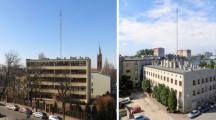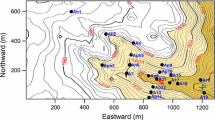Abstract
The mean wind field and the wind fluctuations observed near a controlled, heavily traveled level roadway were investigated. The mean wind field was studied in terms of velocity defects relative to the ambient mean wind. The wind fluctuations were studied in terms of energy spectra, velocity cross-spectra, excesses of velocity variances and cross-covariances over their ambient values. Two-point cross-spectra and correlations were also used to study the propagation of wind fluctuations. The influence of traffic on the ambient wind field extended vertically up to at least 4.5m above ground, and horizontally to at least 30 m downwind of the road. The vertical extension was more gradual at high cross-road winds than at low cross-road winds. The wind tended to move up as it approached the road and down as it left the road, except when the cross-road wind was low, where the downward motion was reduced or reversed. This is likely due to the buoyancy effect of the heated exhaust. The traffic effects propagated outward at about 1 m s-1. Thus at cross-road winds of less than 1 ms-1, the influence of traffic could be observed upwind of the road. When intense shear existed between the local wind field and an opposing traffic direction, large turbulent energy production resulted, generating large eddies, in additions to the high frequency (> 0.1 Hz) eddies generated by vehicular motions in the absence of intense shear. The large eddies also increased the mixing volume, so that when the ambient wind opposed the traffic direction on the upwind lanes, the pollutant concentration upwind of the road could be higher than that downwind. While the cross-covariance excesses generally agreed with the gradient transport assumption, disagreements also existed, which may not be surprising in view of the participation of large eddies in the momentum transport.
Similar content being viewed by others

References
Bendat, J. S. and Piersol, A. G.: 1971, Random Data: Analysis and Measurement Procedures, Wiley-Interscience, New York.
Cadle, S. H., Chock, D. P., Monson, P. R., and Heuss, J. M.: 1977, ‘General Motors Sulfate Dispersion Experiment: Experimental Procedures and Results’, J. Am. Poll. Control Assoc. 27, 33–38.
Chock, D. P.: 1977, ‘General Motors Sulfate Dispersion Experiment-An Overview of the Wind, Temperature and Concentration Fields’, Atmos. Environ. 11, 553–559.
Chock, D. P.: 1978, ‘An Advection-Diffusion Model for Pollutant Dispersion near Roadways’, J. Applied Meteorol. 17, 976–989.
Dabberdt, W. F.: 1977, ‘Air Quality On and Near Roadways: Experimental Studies and Model Development’, SRI Project 2761, SRI International, Menlo Park, California, August.
Garratt, J. R.: 1975, ‘Limitations of the Eddy-Correlation Technique for the Determination of Turbulent Fluxes Near the Surface’, Boundary-Layer Meteorol. 8, 255–259.
Gill, G. C.: 1975, ‘Development and Use of the Gill UVW Anemometer’, Boundary-Layer Meteorol. 8, 475–495.
Hicks, B. B.: 1972, ‘Propeller Anemometers as Sensors of Atmospheric Turbulence’, Boundary-Layer Meteorol. 3, 214–228.
Horst, T. W.: 1971, ‘A Computer Algorithm for Correcting Noncosine Response in The Gill Anemometer’, BNWL-1651–1, pp. 183–186, Battelle, Pacific Northwest Laboratories, Richmond, Washington.
Horst, T. W.: 1973, ‘Corrections for Response Errors in a Three-Component Propeller Anemometer’, J. Applied Meteorol. 12, 716–725.
McBean, G. A.: 1972 ‘Instrument Requirements for Eddy-Correlation Measurements’, J. Applied Meteorol. 11, 1078–1084.
McBean, G. A.: 1975, ‘Comments on “Limitations of the Eddy-Correlation Technique for the Determination of Turbulent Fluxes Near the Surface”’, Boundary-Layer Meteorol. 9, 361–362.
Mizuno, T. and Panofsky, H. A.: 1975, ‘The Validity of Taylor's Hypothesis in the Atmospheric Surface Layer’ Boundary-Layer Meteorol. 9, 375–300.
Panofsky, H. A. and Mizuno, T.: 1975, ‘Horizontal Coherence and Pasquill's Beta’, Boundary-Layer Meteorol. 9, 248–256.
Rikiishi, K.: 1976, ‘Methods of Computing the Power Spectrum for Equally Spaced Time Series of Finite Length’, J. Applied Meteorol. 15, 1102–1110.
Author information
Authors and Affiliations
Rights and permissions
About this article
Cite this article
Chock, D.P. General motors sulfate dispersion experiment. Boundary-Layer Meteorol 18, 431–451 (1980). https://doi.org/10.1007/BF00119498
Accepted:
Issue Date:
DOI: https://doi.org/10.1007/BF00119498



